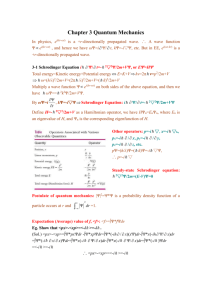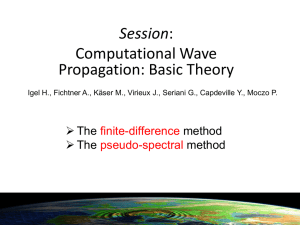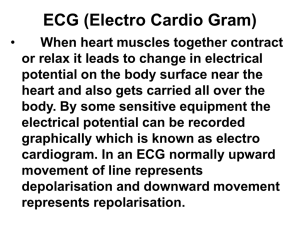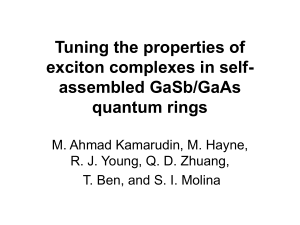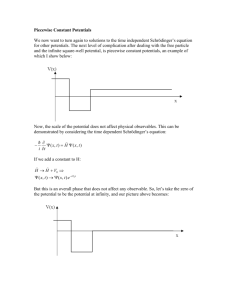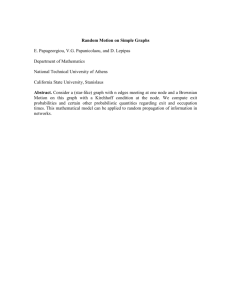投影片 1
advertisement
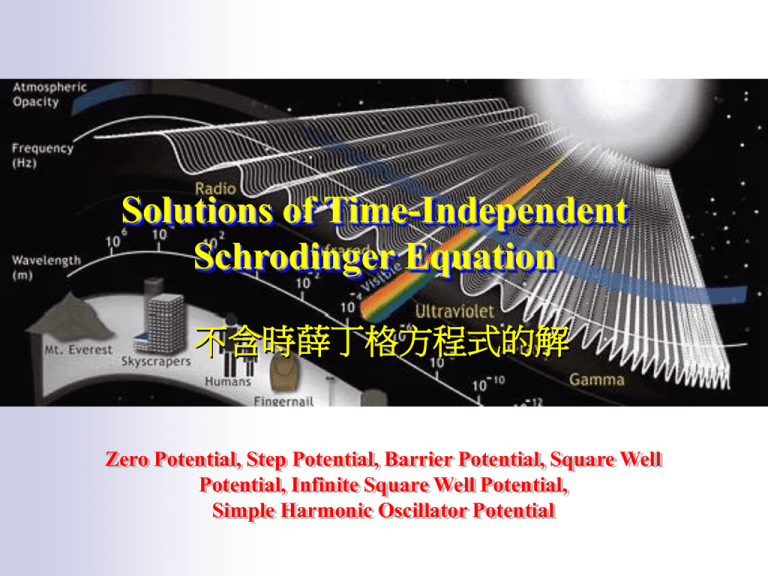
Solutions of Time-Independent Schrodinger Equation 不含時薛丁格方程式的解 Zero Potential, Step Potential, Barrier Potential, Square Well Potential, Infinite Square Well Potential, Simple Harmonic Oscillator Potential 6-2 The zero potential Time independent Schrodinger equation is ˆ (x) E (x) H 2 d2 ( V) (x) E (x) 2m dx 2 d2 2m (x) (E V) (x) 0 2 2 dx 2m (x) 2 (E V) (x) 0 (x) 2mE 2 (x) 0 Let solution is (x) e ikx k2 2mE 2 k 2mE / (x) c1eikx c2eikx k 2mE / (x) Asin(kx) Bcos(kx) A i(c1 c2 ) , B c1 c2 Eigenfunction of free paritcle (x) c1eikx c2eikx k 2mE / (x, t) (x)eiEt / (x)eit wavefunction of free paritcle c1ei(kx t) c2ei(kx t) (x) eikx E , E0 , (x, t) ei(kx t) ,wave is traveling in the direction of increasing x. (x) eikx , (x, t) ei(kx t) ,wave is traveling in the direction of decreasing x. Plane wave k kx-t = constant, kx+t=constant dx dt dx 0 v dt dt dt k k dx dt dx 0 v dt dt dt k wave velocity If c1= c2 ,there are two oppositely directed traveling waves that combine to form a standing wave. 1 t 1 kx t (n ) x (n ) Node position: 2 k 2 k Consider the wave of free particle traveling in the direction of increasing x. (x) Aeikx , (x, t) Aei(kx t) Calculate the expectation value of the momentum p p (x, t)pˆ (x, t)dx * * (x, t) (x, t)dx A 2 ei(kx t ) ei(kx t ) dx k A 2 ei(kx t ) ( k)ei(kx t ) dx )Aei(kx t ) dx x Aei(kx t ) Aei(kx t ) dx Aei(kx t ) (i ( k)A 2 2mE / e i(kx t ) ei(kx t ) dx A 2 e i(kx t ) ei(kx t ) dx p 2mE k * (x, t)(x, t)dx 1 The wave of free particle traveling in the direction of decreasing x. (x) Beikx , (x, t) Bei(kx t) Calculate the expectation value of the momentum p p (x, t)pˆ (x, t)dx * * (x, t) (x, t)dx )Bei(kx t ) dx x Bei(kx t ) Bei(kx t ) dx Bei(kx t ) (i B2 ( k) ei(kx t ) e i(kx t ) dx B 2 ei(kx t ) ei(kx t ) dx p 2mE k k 2mE / x p 2 The momentum of the particle is precisely known x p 0 p k These wave functions contain only a single value of the wave number k. The probability density * for a group traveling wave function of a free particle. With increasing time the group moves in the direction of increasing x, and also spreads. Probability flux(機率通量) (x, t) 2m t 2 * 2 * ( V) (x, t) i (x, t) 2m t (1) * (2) ( 2 2 V)(x, t) i (1) (2) (*) i [ (* * )] 0 t 2m * j 0 t 表變化 表流出 機率密度 i j (* * ) 2m 機率守恆方程 流出=變化 機率通量 Consider wavefunction (x, t) Aei(kx t) 機率密度 * A*A 機率通量 i j (* * ) 2m k * A A vA*A m wave velocity 6-3 The step potential (energy less than step height) 0 V(x) V0 , x 0 (free particle) Running wave , x 0 Exponential decay ( II ) (I) 2m (x) (E 0)1 (x) 0 2 1 (x) 2m (V E) (x) 0 0 2 2 2 ik1x ik1x (x) Ae Be , k1 2mE / 1 k2x k2x (x) Ce De , k 2 2m(V0 E) / 2 x , (x) 0 C 0 B.C 1 ik1x ik1x , k1 2mE / 1 (x) Ae Be k2x (x) De , k 2 2m(V0 E) / 2 Consider continuity of Ψ(x) at x=0 Consider continuity of dΨ(x)/dx at x=0 B.C 2 B.C 3 The wavefunction is (x, t) (x)eiEt / Reflection coefficient The combination of an incident and a reflected wave of equal intensities to form a standing wave. Running wave Exponential decay Forbidden region Penetration depth * (x, t)(x, t) D*De2k2x D*D(e1 )2 Penetration depth x 1/ k 2 / 2m(V0 E) Form uncertainty relation E E Vo Example 6-1. Estimate the penetration distance x for a very small dust particle, of radius r=10-6m and density =104kg/m3, moving at the very low velocity v=10-2m/sec, if the particle impinges on a potential of height equal to twice its kinetic energy in the region to the left of the step. Vo-E = K Example 6-2. A conduction electron moves through a block of Cu at total energy E under the influence of a potential which, to a good approximation, has a constant value of zero in the interior of the block and abruptly steps up to the constant value Vo>E outside the block. The interior value of the potential is essentially constant, at a value that can be taken as zero, since a conduction electron inside the metal feels little net Coulomb force exerted by the approximately uniform charge distributions that surround it. The potential increases very rapidly at the surface of the metal, to its exterior value Vo, because there the electron feels a strong force exerted by the nonuniform charge distributions present in that region. This force tends to attract the electron back into the metal and is, of course, what causes the conduction electron to be bound to the metal. Because the electron is bound, Vo must be greater than its total energy E. The exterior value of the potential is constant, if the metal has no total charge, since outside the metal the electron would feel no force at all. The mass of the electron is m=9×10-31kg. Measurements of the energy required to permanently remove it form the block. i.e., measurements of the work function, show that Vo-E = 4ev. From these data esitmate the distance x that the electron can penetrate into the classically excluded region outside the block. 6-4 The step potential (energy greater than step height) 0 V(x) V0 ,x 0 ,x 0 2m 1 (x) 2 (E 0)1 (x) 0 (x) 2m (E V ) (x) 0 0 2 2 2 (I) ( II ) 1 (x) Aeik1x Beik1x , k1 2mE / ik 2 x ik 2 x (x) Ce De , k 2 2m(E V0 ) / 2 x 0 , (x) no reflection wave D 0 B.C 1 ik1x ik1x , k1 2mE / 1 (x) Ae Be ik 2 x (x) Ce , k 2 2m(E V0 ) / 2 Consider continuity of Ψ(x) at x=0 Consider continuity of dΨ(x)/dx at x=0 B.C 2 B.C 3 The wavefunction is (x, t) (x)eiEt / T j2 j1 (k1 k 2 )2 4k1k 2 R T 1 2 2 (k1 k 2 ) (k1 k 2 ) 表粒子數守恆 R+T=1 當k1、k2互換(入射方向變換),R與T均不變,表Vo增加與Vo減小的效果是相同的。 所以反射波的產生乃由於V(x)的不連續,與V(x)增加或減小無關。 Example 6-3. When a neutron enters a nucleus, it experiences a potential energy which drops at the nuclear surface very rapidly from a constant external value V=0 to a constant internal value of about V=-50 Mev. The decrease in the potential is what makes it possible for a neutron to be bound in a nucleus. Consider a neutron incident upon a nucleus with an external kinetic energy K=5Mev, which is typical for a neutron that has just been emitted from a nuclear fission. Estimate the probability that the neutron will be reflected at the nuclear surface, thereby failing to enter and have its chance at inducing another nuclear fission. A neutron of external kinetic energy K incident upon a decreasing potential step of depth Vo, which approximates the potential it feels upon entering a nucleus. Its total energy, measured from the bottom of the step potential, is E. 6-5 The barrier potential 0 V(x) V0 0 , E’ x0 (I) , 0xa , xa ( II ) ( III ) Case of E V0 2m (x) (E 0)1 (x) 0 , x0 2 1 2m (x) (V0 E) 2 (x) 0 , 0 x a 2 2 2m (x) (E 0) 3 (x) 0 , x a 2 3 1 (x) Aeikx Be ikx x x (x) Fe Ge 2 (x) Ceikx De ikx 3 x a , (x) , k 2mE / , 2m(V0 E) / no reflection wave D 0 B.C 1 E For continuous at x = 0 and x = a for (x) & (x) FG AB F G ik (A B) a a ika Fe Ge Ce ik a a ika Fe Ge ( )Ce , 1 (0) 2 (0) (1) , 1 (0) 2 (0) (2) , 2 (a) 3 (a) (3) , 2 (a) 3 (a) (4) 1 ik ik 1 F [(1 )A (1 )B] [( ik)A ( ik)B] 2 2 G 1 [(1 ik )A (1 ik )B] 1 [( ik)A ( ik)B] 2 2 C ik ika a C F (1 )e ( ik)eika a 2 2 C ik ika a C G (1 )e ( ik)eika a 2 2 , (1) (2) (5) , (1) (2) (6) , (3) (4) (7) , (3) ( 4) (8) ( ik)A ( ik)B ( ik)Ceika a ika a ( ik)A ( ik)B ( ik)Ce , (5) (7) (9) , (6) (8) (10) [( ik)2 ( ik)2 ]A [( ik)2 ea ( ik)2 ea ]Ceika , (9) ( ik) (10)( ik) (11) (4ik)A [(2 k 2 )(ea ea ) 2ik(ea ea )]Ceika a a a a A e e e e [( 2 k 2 )( ) 2ik( )]eika /(2ik) C 2 2 [(2 k 2 )sinh(a) 2ik cosh(a)]eika /(2ik) A*A 2 2 2 2 2 2 2 2 2 [( k ) sinh ( a) 4 k cosh ( a)]/(4 k ) * CC ( 2 k 2 ) 2 2 2 2 2 sinh ( a) cosh ( a) , cosh y 1 sinh y 2 2 4 k ( 2 k 2 ) 2 2 1 sinh (a) 2 2 4 k 穿透係數 v3C*C ( 2 k 2 ) 2 2 1 T [1 sinh ( a)] v1A*A 4 2 k 2 4E(Vo E) T 4E(Vo E) Vo2 sinh 2 a For a >> 1 sinh 2 a 1 a a 2 1 2 a (e e ) e 4 4 Vo2 sinh 2 a 1 T [1 ] 4E(Vo E) Vo2e2a [1 ]1 16E(Vo E) Vo2e2a [ ]1 16E(Vo E) e2 a 16E(Vo E) V2 o Case of E E V0 i , 2m(E Vo ) / 2 2 2m(E Vo ) / (k 2 2 )2 2 1 T [1 sinh (i a)] 42 k 2 Vo2 [1 (i sin a) 2 ]1 4E(E Vo ) 4E(E Vo ) 4E(E Vo ) Vo2 sin a
